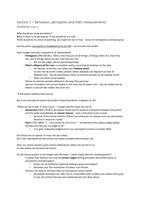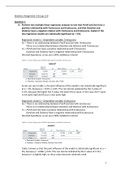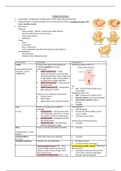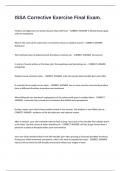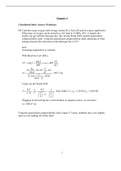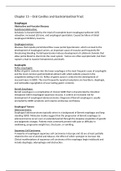Module 5: Cognitive Development in Infancy and Toddlerhood
Lesson 9: Cognitive Development
Cognitive Types of Learning
- Habituation: a decrease in response to a stimulus after repeated presentations.
APA defines habituation as "growing accustomed to a situation or stimulus,"
which diminishes its effectiveness.
AKA “getting bored with repeated stimulus”
- Novelty preference: a task in which an infant is shown a new object simultaneously
with a familiar one.
Used in studies of infant cognition, based on the fact that infants will visually
inspect a new object in preference to looking at a familiar object.
- A measure of learning and memory
How quickly infants habituate related to efficiency of taking in info
Habituation rate, novelty preferences in infancy correlated with later-
measured IQ up to 18 years later
o Faster habituation, more novelty preference = higher IQ
Conditioning
- Classical conditioning (Pavlov)
Unconditioned stimulus reliably elicits unconditioned response
o No learning here – a reflex e.g., baby sucks nipple in mouth
When an initially neutral stimulus (sight of nipple) is constantly paired with
the unconditioned one (feeling of nipple) this eventually makes the sucking
response happen with soley the sight of the nipple.
o Now a conditioned response (sucking) elicited by the conditioned
stimulus (sight of the nipple)
o Newborns show this with puff air to eye paired with a tone –
eventually blink upon hearing tone.
- Instrumental/operant Conditioning (Skinner)
Learning the relationship between causes (operants) and effects
E.g., mobile study
Infants appear highly motivated to do this (active child)
Begins at 2 months; as age more complex
Statistical Learning
- Statistical learning: detecting predictable patterns of associations
Track regularities, or transitional probabilities (TP) of info in environment
Red, blue, blue, red, blue, blue, red, blue, blue, red, blue, blue, red, blue,
blue…
o TP: If red, then blue = 100%
o If blue then red = 50%
Infants look longer when things disrupt TPs
Very simple versions shown in newborns
Critical for language learning
Infants not only extract patterns but prefer “most informative” patterns
o Look longest at things that are neither too basic nor too complex
o “Goldilocks Effect” (Kidd et al. 2012) infant's preference to attend
events that are neither too simple nor too complex according to their
current representation of world.
, o In education materials are neither too easy nor too difficult, too simple
nor too complex or too little nor too much.
Imitation
- Observational learning or social learning
- Learning by observing and reproducing other behaviours
E.g., Newborns imitate facial gestures (Meltzoff & Moore 1977)
Recently failed to replicate, ut some issues with design (Oostenbroek et al
2016)
- More and more complex actions imitated as infants age
Clear evidence of imitating actions on objects by 6 months
Infants imitate after longer and longer delays (deferred imitation)
o Evidence of memory
- Imitation is a powerful cultural learning tool explains how “we” do things
Infants do not imitate novel actions blindly appears rational
Infants do not imitated everyone, very selective reliable agents
- Not limited to learning what to do but also more abstract things
E.g., Baby ‘grit’ learning (Leonard et al 2017)
o 15 month old infants given a broken toy – how long do they try to get
it to work?
o Study ends when they cry or throw the toy away
o After having seen someone either a) work really hard to do something
or b) fix easily
o Infants persisted twice as long (on a different task) after observing
effort
Major Theories of Cognitive Development
- Piagetian
- Information Processing
- Core Knowledge
- Sociocultural
Jean Piaget (1896 – 1980)
- Most influential developmental psychologist ever
- Ideas often held up as the standard against which to consider evidence
- Most non-psychologist shocked to hear (some of) his conclusions being
reinterpreted
- Piagetian Theory
Child actively constructs knowledge Piagetian constructivism
Child is the scientist – generates hypotheses, performs experiments, draws
conclusions
Child is motivated and an active learner – learning for its own sake
“It is the nature of the child to react to its nurture”
- Developmental processes:
Assimilation: fit new information into existing mental structures (or
“schemas”)
Accommodation: change schemas in response to new experiences
o Schema development through processes of assimilation and
accommodation to maintain equilibrium
Equilibration: balance assimilation and accommodation
, - Piaget Stage Theorist
A stage theorist: development proceeds in a series of distinct, discontinuous
stages
Each stage is a coherent way of understand the world, each is fundamentally
different from the last
o To move stages you have to make an intellectual leap – perhaps
when you can no longer assimilate new information into overall
theories of how the world works.
- Quantitative change: thinkers in one stage are different kinds of thinkers than in
other stages (not just better/worse)
E.g., first babies believe objects no longer exist when they go out of sight
Brief transitions between stages in which might fluctuate, generally don’t
- Domain-general: apply to all aspects of the world
- Invariant order: no skipped stages
Piaget Stages
- The Sensorimotor Stage (0 – 2 years)
Concerned with object concept how an infant understands properties of
solid objects
o Object permanence = object exist outside of infants’ experience
with them
Contains 6 distinct stages
1. Stage 1: Reflexes (0 – 1 month)
o Reflexes most primitive form of schema
o Development = schema modified, improved upon the 1 st month
(improvements on breast feeding)
o Object concept: objects do not exist outside of infants interactions
with them sensori & motor
o Same object (to us) many different objects to infants) the mom
they see, hear, smell, taste, feel, all different infant cannot integrate
across.
2. Stage 2: Primary Circular Reactions (2 – 4 months)
o Motor schema from stage 1 are applied to new objects by chance
o Repeated because produce a desired effect – feels good
o Usually happens on infant’s own body (lip licking scheme)
o Objects still wholly embedded within schema
3. Stage 3: Secondary Circular Reactions (4 – 9 months)
o Schema applied to objects outside of their own body
o Through accident and accommodation, new schema begin to
develop specific to particular objects
o Rattle-shaking scheme doesn’t apply to new rattles or other things
o Object concept: getting better, objects embedded in schema
4. Stage 4: Coordination of Secondary Schema (9 – 12 months)
o Large # of independent schema get coordinated into a few
complex and flexible schema
o Means-ends behaviour emerges pulling something to bring
something else closer
o Applying multiple schema to the same object allows for object
permanence objects now have enduring properties

